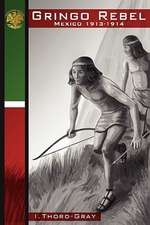Women Made Visible: Feminist Art and Media in Post-1968 Mexico City: The Mexican Experience
Autor Gabriela Aceves Sepúlvedaen Limba Engleză Paperback – 31 mar 2019
2020 Canadian Association for Latin American and Caribbean Studies (CALACS) Book Prize
In post-1968 Mexico a group of artists and feminist activists began to question how feminine bodies were visually constructed and politicized across media. Participation of women was increasing in the public sphere, and the exclusive emphasis on written culture was giving way to audio-visual communications. Motivated by a desire for self-representation both visually and in politics, female artists and activists transformed existing regimes of media and visuality.
Women Made Visible by Gabriela Aceves Sepúlveda uses a transnational and interdisciplinary lens to analyze the fundamental and overlooked role played by artists and feminist activists in changing the ways female bodies were viewed and appropriated. Through their concern for self-representation (both visually and in formal politics), these women played a crucial role in transforming existing regimes of media and visuality—increasingly important intellectual spheres of action. Foregrounding the work of female artists and their performative and visual, rather than written, interventions in urban space in Mexico City, Aceves Sepúlveda demonstrates that these women feminized Mexico’s mediascapes and shaped the debates over the female body, gender difference, and sexual violence during the last decades of the twentieth century.
Weaving together the practices of activists, filmmakers, visual artists, videographers, and photographers, Women Made Visible questions the disciplinary boundaries that have historically undermined the practices of female artists and activists and locates the development of Mexican second-wave feminism as a meaningful actor in the contested political spaces of the era, both in Mexico City and internationally.
In post-1968 Mexico a group of artists and feminist activists began to question how feminine bodies were visually constructed and politicized across media. Participation of women was increasing in the public sphere, and the exclusive emphasis on written culture was giving way to audio-visual communications. Motivated by a desire for self-representation both visually and in politics, female artists and activists transformed existing regimes of media and visuality.
Women Made Visible by Gabriela Aceves Sepúlveda uses a transnational and interdisciplinary lens to analyze the fundamental and overlooked role played by artists and feminist activists in changing the ways female bodies were viewed and appropriated. Through their concern for self-representation (both visually and in formal politics), these women played a crucial role in transforming existing regimes of media and visuality—increasingly important intellectual spheres of action. Foregrounding the work of female artists and their performative and visual, rather than written, interventions in urban space in Mexico City, Aceves Sepúlveda demonstrates that these women feminized Mexico’s mediascapes and shaped the debates over the female body, gender difference, and sexual violence during the last decades of the twentieth century.
Weaving together the practices of activists, filmmakers, visual artists, videographers, and photographers, Women Made Visible questions the disciplinary boundaries that have historically undermined the practices of female artists and activists and locates the development of Mexican second-wave feminism as a meaningful actor in the contested political spaces of the era, both in Mexico City and internationally.
| Toate formatele și edițiile | Preț | Express |
|---|---|---|
| Paperback (1) | 257.64 lei 43-57 zile | |
| Nebraska – 31 mar 2019 | 257.64 lei 43-57 zile | |
| Hardback (1) | 469.46 lei 43-57 zile | |
| Nebraska – 31 mar 2019 | 469.46 lei 43-57 zile |
Din seria The Mexican Experience
-
 Preț: 202.32 lei
Preț: 202.32 lei -
 Preț: 282.57 lei
Preț: 282.57 lei -
 Preț: 307.01 lei
Preț: 307.01 lei -
 Preț: 185.84 lei
Preț: 185.84 lei -
 Preț: 288.19 lei
Preț: 288.19 lei -
 Preț: 215.61 lei
Preț: 215.61 lei -
 Preț: 217.70 lei
Preț: 217.70 lei -
 Preț: 432.39 lei
Preț: 432.39 lei -
 Preț: 222.92 lei
Preț: 222.92 lei -
 Preț: 255.52 lei
Preț: 255.52 lei -
 Preț: 362.33 lei
Preț: 362.33 lei -
 Preț: 217.70 lei
Preț: 217.70 lei -
 Preț: 211.92 lei
Preț: 211.92 lei -
 Preț: 260.15 lei
Preț: 260.15 lei -
 Preț: 290.14 lei
Preț: 290.14 lei -
 Preț: 253.79 lei
Preț: 253.79 lei -
 Preț: 217.52 lei
Preț: 217.52 lei -
 Preț: 145.50 lei
Preț: 145.50 lei -
 Preț: 256.28 lei
Preț: 256.28 lei -
 Preț: 257.25 lei
Preț: 257.25 lei -
 Preț: 219.43 lei
Preț: 219.43 lei -
 Preț: 214.03 lei
Preț: 214.03 lei -
 Preț: 325.44 lei
Preț: 325.44 lei -
 Preț: 288.19 lei
Preț: 288.19 lei -
 Preț: 363.86 lei
Preț: 363.86 lei -
 Preț: 290.14 lei
Preț: 290.14 lei -
 Preț: 326.25 lei
Preț: 326.25 lei -
 Preț: 257.09 lei
Preț: 257.09 lei -
 Preț: 305.50 lei
Preț: 305.50 lei -
 Preț: 291.08 lei
Preț: 291.08 lei -
 Preț: 217.52 lei
Preț: 217.52 lei -
 Preț: 142.44 lei
Preț: 142.44 lei -
 Preț: 216.55 lei
Preț: 216.55 lei
Preț: 257.64 lei
Nou
Puncte Express: 386
Preț estimativ în valută:
49.30€ • 51.60$ • 41.03£
49.30€ • 51.60$ • 41.03£
Carte tipărită la comandă
Livrare economică 31 martie-14 aprilie
Preluare comenzi: 021 569.72.76
Specificații
ISBN-13: 9781496213242
ISBN-10: 1496213246
Pagini: 408
Ilustrații: 53 photographs, 9 illustrations, index
Dimensiuni: 152 x 229 x 24 mm
Greutate: 0.59 kg
Editura: Nebraska
Colecția University of Nebraska Press
Seria The Mexican Experience
Locul publicării:United States
ISBN-10: 1496213246
Pagini: 408
Ilustrații: 53 photographs, 9 illustrations, index
Dimensiuni: 152 x 229 x 24 mm
Greutate: 0.59 kg
Editura: Nebraska
Colecția University of Nebraska Press
Seria The Mexican Experience
Locul publicării:United States
Notă biografică
Gabriela Aceves Sepúlveda is an assistant professor in the School of Interactive Arts and Technology at Simon Fraser University.
Cuprins
List of Illustrations
Acknowledgments
List of Abbreviations
Introduction: Women Made Visible
Part 1. Feminizing the City
1. The Official City
2. The Media City
3. The Embodied City
Part 2. The Archival Practices of a Visual Letrada
4. The Archival and Political Awakenings of Ana Victoria Jiménez
5. Secret Documents and Feminist Practices
6. Performing Feminist Art
Part 3. Protesting the Archive
7. Interrupting Photographic Traditions
8. Feminist Collaborations in 1970s Mexico
9. POLArizing the Archive
Conclusion: New and Emergent Visual Letradas
Notes
Bibliography
Index
Acknowledgments
List of Abbreviations
Introduction: Women Made Visible
Part 1. Feminizing the City
1. The Official City
2. The Media City
3. The Embodied City
Part 2. The Archival Practices of a Visual Letrada
4. The Archival and Political Awakenings of Ana Victoria Jiménez
5. Secret Documents and Feminist Practices
6. Performing Feminist Art
Part 3. Protesting the Archive
7. Interrupting Photographic Traditions
8. Feminist Collaborations in 1970s Mexico
9. POLArizing the Archive
Conclusion: New and Emergent Visual Letradas
Notes
Bibliography
Index
Recenzii
"Women Made Visible is meticulously and creatively researched thanks to the access that the author gained to personal and institutional archives, and to the detailed interviews she conducted with art practitioners and feminist activists. . . . This book will be of interest to scholars of visual and art history and feminist studies, as well as to urban historians, particularly those concerned with the ways in which metropolises like Mexico City become places where countercultural movements flourish."—Tania Islas Weinstein, Latin Americanist
"Timely and necessary, Women Made Visible advances the field of Latin American, Chicanx, and Latinx art history."—Teresa Eckmann, Woman's Art Journal
"Women Made Visible may be of interest to students and scholars who study art, feminism, Mexico, politics, and history."—Margarita H.Tapia, Communication Booknotes Quarterly
“Gabriela Aceves Sepúlveda brilliantly contrasts two primary sources that are not normally read together: private artist archives (and interviews with the artist-archivists) and state security archives. The author’s deeply researched—and theoretically and methodologically sophisticated—study will be an extraordinary resource for this subfield of video art and experimental film in Mexico.”—George Flaherty, author of Hotel Mexico: Dwelling on the ’68 Movement
“An impressive foundation. Women Made Visible adds important women artists to the canon of Mexican art history. Written in a brisk, accessible, but still sophisticated prose style, this book will serve novice and specialist alike.”—Mary K. Coffey, author of How a Revolutionary Art Became Official Culture: Murals, Museums, and the Mexican State




















